THE
FILM
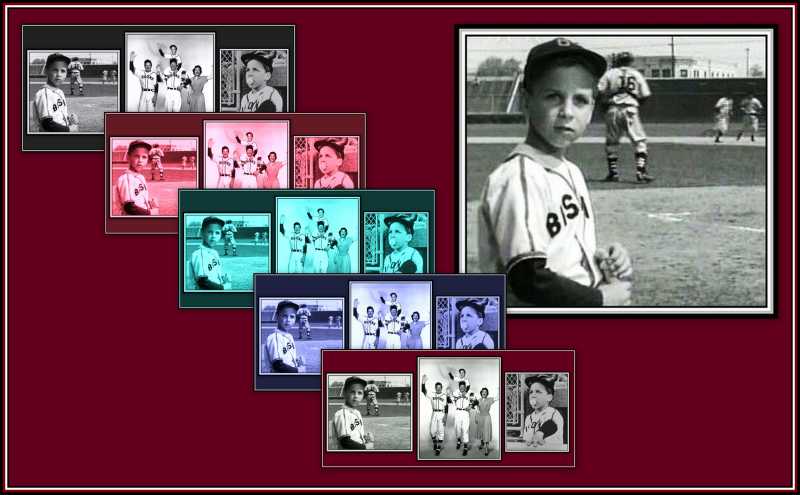
If Johnny
proved to be the original
source of my learning of
the existence of
baseball, it was the
film, The Kid from
Left Field, that
proved to be the key
which unlocked this
hitherto mystical game
and allowed me to see it
in a real situation and
so help refine my
somewhat fantastic ideas
of the game. Not that I
actually understood its
intricacies after
watching the film
however, but it did serve
to show me that it was a
game that generated much
passion and which was
played not only by kids
but by adults too, and
most importantly, I
learned that the game was
fun!
To say
that the film had a
profound effect on my
life may sound overly
dramatic, but
nonetheless, I believe
this to be so. It should
be remembered that I saw
this film in 1953. At
that time Britain was
still living through
austere postwar years.
The average person was
not well off and
rationing, including sweets,
was still in place.
Working class people did
not travel abroad. Most
listened to the radio and
did not, as yet, own a
television. Housing was
poor and many homes still
lacked the simple
amenities of life that
everyone takes for
granted today.
Undoubtedly life was
harder then, but there
were certainly simple
pleasures that gave
people much enjoyment.
One such pleasure was going
to the pictures.

I saw The
Kid from Left Field
on a Saturday afternoon
in 1953 at the Empress,
Mare Street, Hackney,
as part of a double
bill with the 20th
Century Fox’s production
of The Virgin Queen. In
1953, few, if any,
travelled to see a film
unless they dressed
themselves up in their
best clothes and went to
one of the showcase
cinemas of the West
End. Since it cost
much more to see a film
in the West End,
the average cinema-goer,
including me, were forced
to wait for any film of
choice to go on General
Release and come
to a cinema near you.

In 1953,
the average
cinema-goer did not feel
the necessity to travel
to see a film, as every
borough, and many
neighbourhoods within
some of the larger
boroughs, had a number of
cinemas that offered the
latest film releases for
the residents’
pleasure. Each borough
had cinemas belonging to
the major circuits: an Odeon,
a Gaumont, and
an ABC, generally
with a princely name.
In addition, many
boroughs also had a
cinema belonging to one
of the smaller cinema
chains, such as Granada
or Essoldo, as
well as an occasional
small independent cinema
that was not associated
with any chain and where
lesser films were shown.
Although Bethnal
Green
had a number of
cinemas, it quickly
became apparent to any
discerning cinema-goer that
the area lacked a cinema
that could by any stretch
of the imagination be
classified as a Picture
Palace. Even those
cinemas that formed part
of the larger cinema
chains were often of poor
architectural design and
were in a poor state as
building materials were
not available to the
owners since these
materials were needed to
build housing. In
addition, it also became
clear that these cinemas
were excluded from
showing a number of films
that I believed were important
and needed to be
seen. And so when such a
film failed to come to my
area, I decided that
since Mohammed was not
coming to the mountain,
then the Mountain, namely
me, would have to go
to Mohammed (please
make a link here to the
Empress stories) and so I
began my travelling to
see films that I deemed of
value!
Since I
believed that The
Virgin Queen was a
film of value and so
needed to be seen, I was
compelled to travel to Hackney
so as not to miss it.
The Virgin Queen told
the story of the
relationship between
Queen Elizabeth I and Sir
Walter Raleigh and
boasted a cast including
Bette Davis, Richard
Todd, Joan Collins and
Herbert Marshall. It
could be reasoned that
this was a film of
importance since it
portrayed a period of
English history, right?
However, this was not my
reasoning for the sortie
to Hackney. My
interest in seeing this
film did not have its
origins in a desire to
see history come
alive, as one
advertisement boasted. My
interest in the film came
from my interest in the
process used to
photograph it and in the
fantastic effects that it
would produce.
The
spectacular scenes of The
Robe and Demetrius
& The Gladiators introduced
me to the glory of CinemaScope.
Without understanding
why, I had stumbled
across the value of
sitting in the centre of
the fifth or sixth row of
a cinema. Such seating
allowed my visual
field to be filled
with the events shown on
the screen, thereby
giving me the impression
of being part of the
scene. Naturally at my
age I was not aware of
such a concept as a
visual field. All I
wanted was to get in on
the action! The official breakthrough
of CinemaScope,
and its major selling
point, was that the
process produced a
photographic image to stand
out and so allowed
the viewer to experience
this effect without the
aid of special glasses!
Now, how could anyone,
let alone a child, resist
such an invitation?
I am
amused to see how many
bad films are still
skill-fully packaged and
sold to the public in
this manner. This
advertising style is
often used to peddle
certain films
specifically produced for
young children. Today
this method marketing
ploy is used effectively
to bedazzle kids
with the glory of the
new super-duper 3-D
process and in so
doing the producers are
able to slip idiotic
plots and heroes by their
audience. This kind of hype
worked well in the past
and helped swell the
coffers of many a
Hollywood film studio and
it obviously still works
today.

Another selling
point of the films
that appealed to me and
many of my classmates,
besides the glories of CinemaScope,
was the sound, for these
films introduced to the
audience the wonders
of Stereophonic Sound.
This too was a wonder of
the times. From a
marketing prospective,
the Stereophonic Sound
was still in its infancy
at the time and the
average consumer had not
heard it, as only a few long-playing
gramophone records had
been released and these
were purely to
demonstrate its
possibilities.
On that
Saturday afternoon, I had
gone to the Empress,
Mare Street with a
classmate of mine and had
promised to be
home before dark. My
parents were under the
impression that we were
going to a local cinema,
but although the distance
from Stepney to Hackney
is not far, since we were
still very young, they
thought that such a trip,
which required taking a
trolleybus and then
crossing a major road,
was too dangerous for us
without parental
supervision. Since
Saturday was the busiest
day for my parents in
their pie
‘n’ mash shop,
it was out of the
question that either of
them take us there.
Although I cannot recall
the reason why my
classmate’s parents
were unable to accompany
us, I presume that they
had good reason. And so,
it was either not go at
all or go without
parental knowledge.
I do not
advocate telling lies to
anyone. Let us be clear
on this. However, when I
was a child and became
filled with a wanting and
a wishing to do
something, I was
remarkably determined to
do so! Now I can
understand why the casual
observer might wonder
what all the fuss was
about, after all, it was only
a film! And there,
dear reader is the rub,
our bone of contention
and the difference
between the casual
observer and me!
Since
early childhood, I was blessed
with determination and
tenacity. Once I set my
mind to something, it had
to be completed and I
could not be turned away
from a task. Of course,
as a child, what I set my
mind on were simple tasks
that required a
willingness to put in
sufficient time to
achieve the goal. This
generally meant the
building of a sandcastle
before the tide came in
and washed it away or
perhaps completing the
colouring of a picture in
a book before being made
to go to bed. Once I got
older and moved on to
more complex tasks, whenever
some particular pastime
appealed to me, I gave it
my all and threw
myself into its
completion with equal
determination and
dedication and often at
the expense of all else.
I had been
exposed to both cinema
and theatre
at a very young age and
quickly developed a keen
interest in each. Most of
my classmates were avid
cinema goers and were
also attracted by the
possibilities of CinemaScope.
And so, my wish to
see a certain film came
occasionally into odds
with my wish not to go
against my parents. I
have to confess that the
combination of my strong
will and my determination
often won when a conflict
arose.
With the
promise of CinemaScope
and Stereophonic
Sound, The Virgin Queen became
a film of interest. And
once it entered general
release, it became
a film that had to be
seen and caused us to set
out on our Saturday
afternoon odyssey via
trolleybus and across a
dangerous road. No doubt
we assumed that such trials
were worth facing and
worth the guilt that
accompanied them. And
indeed they were, however
what proved surprising to
me was that the prize that
awaited me that afternoon
was not the one that I
had thought.
I remember
being reasonably
impressed by The
Virgin Queen, but I
cannot say that I was
overly so. The other film
shown that afternoon was
one that did not appeal
to my classmate from the
onset. It was called The
Kid from Left Field and
was about baseball!
I remembered Johnny and I
thought about the
braves playing a game
while riding their
horses. I told my friend
about this and he laughed
and we sat there with
high hopes for the film.
Once it began however, we
were disappointed not to
see any indians either
on horseback or foot. My
friend wanted us to
leave, but I was
determined to see the
film to its end. I
secretly hoped that the
indians would appear
sometime in the film.
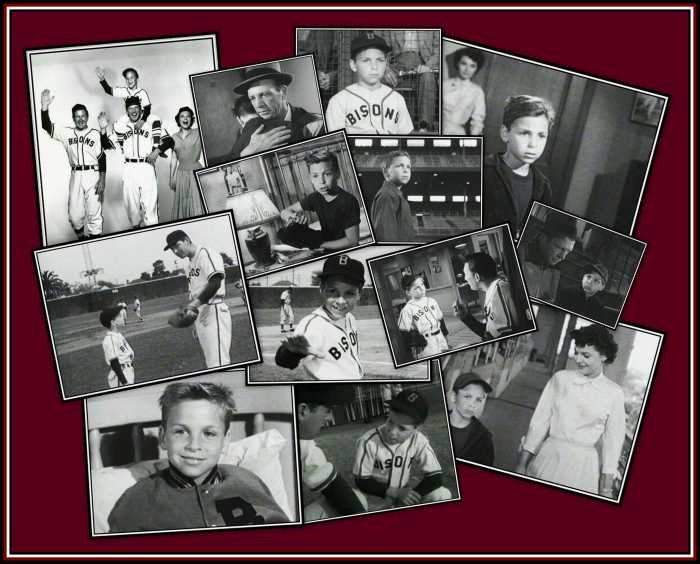
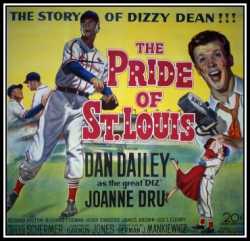 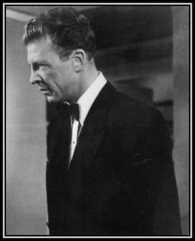 The
film told the story of a
failing baseball team
whose fortunes are
suddenly reversed thanks
to the pointers given
by a little boy. What the
team members do not know
is that the boy is
getting his tips from
his father who once was a
player, now fallen on
hard times thanks to his
manner. The story is
basically a fairy
story, a whimsical
tale of fantasy, but one
that allowed me to
actually see baseball
played for the first
time. The
film told the story of a
failing baseball team
whose fortunes are
suddenly reversed thanks
to the pointers given
by a little boy. What the
team members do not know
is that the boy is
getting his tips from
his father who once was a
player, now fallen on
hard times thanks to his
manner. The story is
basically a fairy
story, a whimsical
tale of fantasy, but one
that allowed me to
actually see baseball
played for the first
time.
I realised
later that one of the
reasons for my liking The
Kid from Left Field was
that it had a strong
cast. At the time I only
knew of Dan Dailey and
this was from his
musicals with Betty
Grable and
with others,
however I later learned
that he was also a serious
actor on occasion and
had made another baseball
film previously about
a real-life player (The
Pride of St. Louis also-known-as
The Dizzy Dean Story).
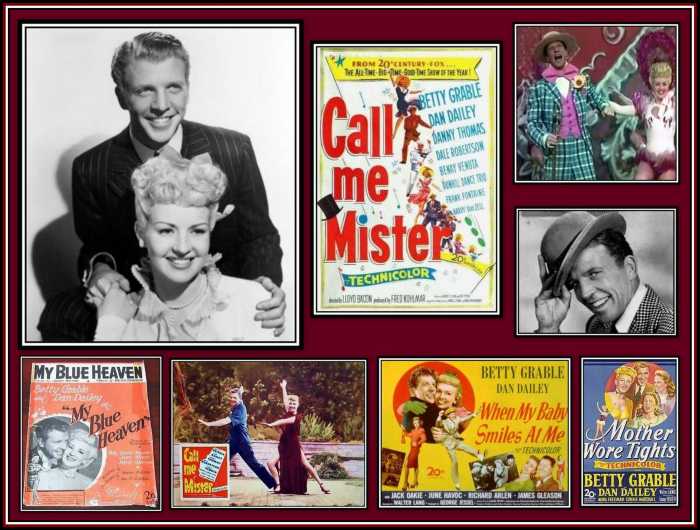
Click on
the collage to see a clip
from one of their films
The first
that I remember seeing
Dan Dailey was in a
delightful film called Chicken
Every Sunday, which
also starred the actress
Celeste Holm in 1949. I
saw this film on a
Saturday afternoon at the
Plaza on Kingsland
Road in Dalston. The
Plaza although old
and in a poor condition
was one of my favourite
cinemas since I would go
there following wandering
through Ridley Road
Market, which was a
great favourite of mine.
The journey to the market
was quite an adventure as
it required the taking of
a little red bus and
passing over what I
thought was a variety of
canals to get there. To
me, this seems like an exotic
journey as, if one
was lucky, one got to see
a horse pulling a barge
as one went over the
bridge. The route was
extremely twisty and
turny and we were
thrown from side to side
as the driver manoeuvred
his way through the
streets. The market was a
joy for me with all kinds
of foods that I had never
seen before. I note today
that huge beef tongues
and various species of
brain and stomach are
still for sale there. We
would eat a variety of
delicacies as we walked
through the market. I was
quite conservative in
those days and feasted on
saveloys, chips and cake
followed by a pie-a-mash
in Cooke’s on
Kingsland Road. Once
inside the cinema, an
assortment of cake and
ice cream were eaten.
This cinema specialised
in second run film
releases. As a result, I
got to see many great
films here including Kings
Row and Now
Voyager.
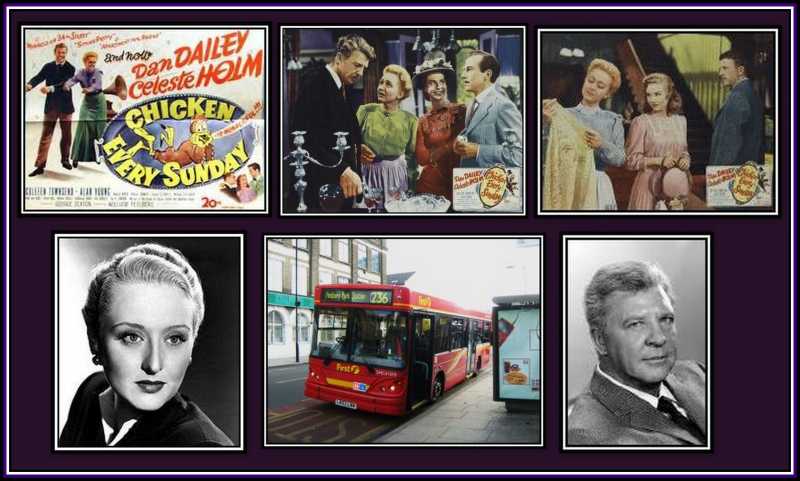
Click on
the pictures of Celeste
Holm and Dan Dailey to
see clips
Other
members of the cast
included Anne Bancroft,
Lloyd Bridges, Ray
Collins and Richard Egan.
Anne Bancroft was a
versatile actress who won
an Oscar for her role in The
Miracle Worker. She
played a wide variety of
roles in over fifty films
including the iconic Mrs.
Robinson in The
Graduate, an ageing
ballerina in The
Turning Point and a
book collector in 84
Charing Cross Road. She
also played Winston
Churchill’s mother
in Young Winston and
a nun on two occasions in
Agnes of God and Critical
Care. Of all her
roles, my favourites are
as Mary Magdalene in
Franco Zeffirelli’s
television epic, Jesus
of Nazareth and as
the dying mother with the
wish to meet Greta Garbo
in Garbo Talks.

Lloyd
Bridges played a baseball
player who profits from
the help given by The
Kid from Left Field. He
is at the end of his
career and is tore
between leaving baseball
and taking a job selling
insurance or cars or
something, which I cannot
recall. He befriends The
Kid and the result is
that they give believable
performances. Lloyd
Bridges was a great
favourite of mine as a
result of his television
series, Sea Hunt, which
I remember watching each
Sunday evening before
being made to go to bed.
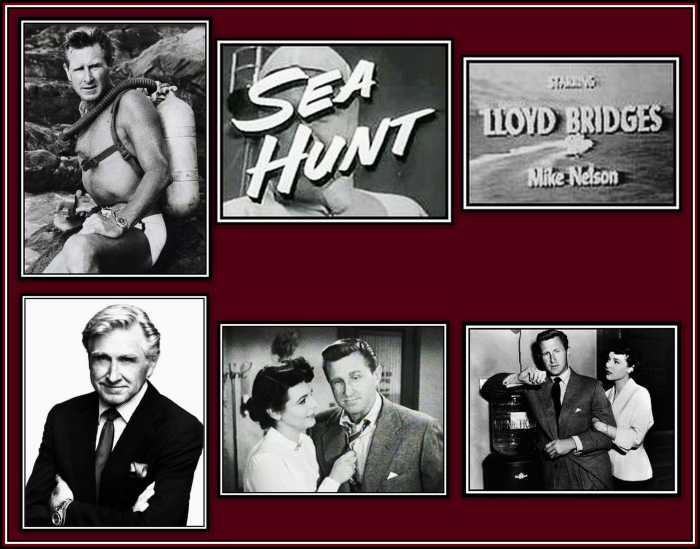
Richard
Egan plays the villain of
the film. He is the
manager who dislikes The
Kid since he realises
that he of more help to
and so has a greater
impact on the players
than he. Ray Collins, a
great veteran and
character actor, plays
the team owner who is
prepared to elevate The
Kid to managerial
status. It is hard of
course today to see him
as anything but Lt.
Tragg after his great
performances in the Perry
Mason television
series.

The Kid
is played by Billy
Chapin, who went on to
make a number of films as
a child actor. He later
moved into television,
but was unable to make
the transition to adult
actor. His brother
and sister were also
child stars. His sister,
Lauren Chapin, appeared
in the television series,
Father knows best (1954-1960),
and is perhaps best
remembered for writing
her tell-all book
on her life as a child
actress. Apparently in
her book she alludes to
the difficulties that her
brother experienced in
his young adulthood. As a
child, he appeared in There’s
no business like show
business with Dan
Dailey once more, A
Man called Peter with
Richard Todd and Jean
Peters and Violent
Saturday with Victor
Mature. His most famous
role was in The Night
of the Hunter, the
only film directed by
Charles Laughton.
Apparently, Mr. Laughton
chose him specifically
for his role in the film
since he was considered a
good acting technician with
flexibility and an
ability to understand the
construction of a scene.
After this, he acting
mainly in television.
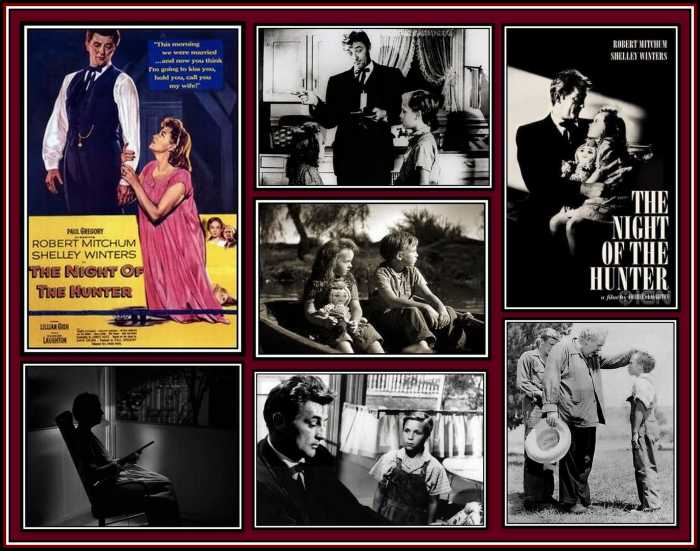
Click on
the colour
poster to see the
trailer of the film
Click on
the black & white
poster to see a clip from
the film
Click on
the lady with a gun to
see a clip from the film
Click on
the bottom right-hand
picture for a clip of the
finale of the film
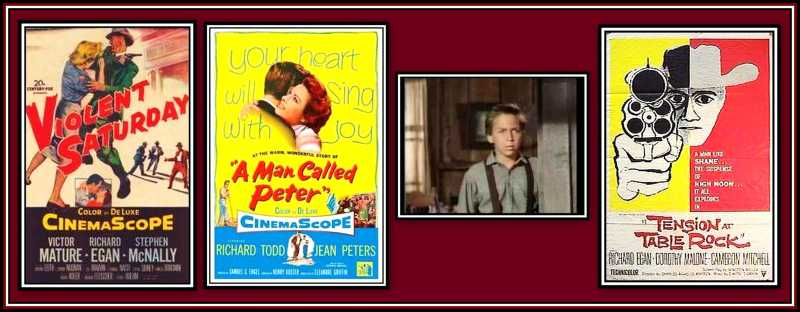
My
classmate did not enjoy
this film at all and
complained throughout the
whole journey home about
it. I, on the other hand,
liked the film and could
not understand why he was
so opposed to it. Anyway,
since we had stayed to
watch this film, we
arrived home after dark.
My parents, and I assume
his too, were not pleased
and I suffered multiple
restrictions to my
movement for a while.
Still, the punishment was
worth it simply for
seeing how baseball was
played.
Although
this was my first
baseball film, I later
learned that it was not
the first one produced.
There have been many film
both before and after
with baseball as a
setting. Over the years,
I have seen most of them
and as good as many are I
have a soft spot for
this film.
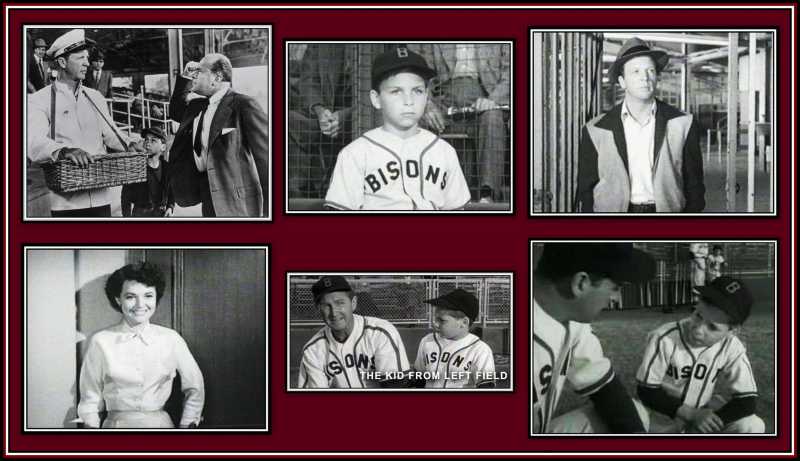
My
favourite pre-The Kid
from Left Field-film
is The Pride of the
Yankees. Here Gary
Cooper gives a brilliant
performance while playing
Lou Gehrig of The New
York Yankees. Tragically,
he is forced to leave
baseball at the age of 36
after developing the
neurological degenerative
disease, amyotropic
lateral sclerosis (ALS), which
is commonly known in
North America as Lou
Gehrig’s Disease. The
highlight of Gary
Cooper’s performance
is his parting speech to
the fans following his
final game. It is here
that in spite of the
tragedy that has befallen
him he delivers the
famous quote, "today,
I consider myself the
luckiest man on the face
of the earth".
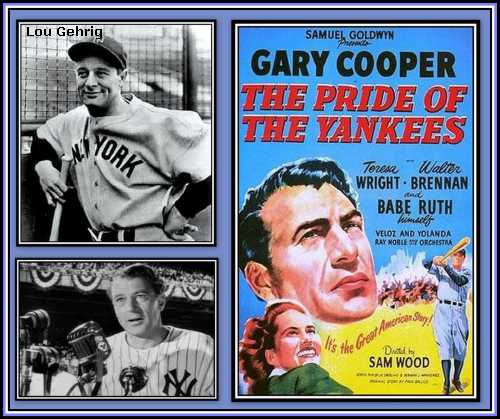
My
favourite post-The Kid
from Left field-film
is Field of Dreams. This
is a film with a profound
mystical quality.
Baseball, known at the
nation’s pastime,
once inspired such
thought and players once
spoke of the game in hushed
tones. Field of
Dreams is the story
of a farmer in
Iowa, in the Mid-West of
the United States, who is
convinced that he must
clear part of his corn
fields and turn the area
into a baseball field. He
does this as he does not
want to turn into his
father, whom he
resents for his lack
of spontaneity.
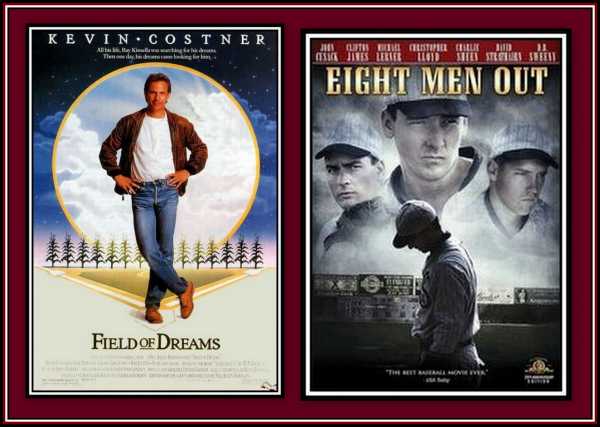
The film
is renowned for the
quote, "if you
build it, he will
come". Once the
baseball field is lain
out, the great Shoelace
Joe Jackson comes and
asks if he can bring some
of his friends to play
there. These are the
eight men banned from
baseball following their
conviction for throwing
the 1919 Baseball World
Series. They had
played for the Chicago
White Sox and
following the scandal
become collectively known
as the Chicago Black
Sox and were never
allowed to play
professional sports
again.
At the
heart of the film is the
farmer’s regret that
his relationship with his
father, who was a
baseball player, had not
been better. Eventually
it becomes clear to the
farmer that the He who
will come is his
father whom he
recognises as a young catcher
collecting his things
at the end of a game.
Following some simple
conversation, the two
men, father and son, get
the opportunity to do
many of the things that
they had failed to do
when the farmer was a
child. The film has a
stellar cast who give
great performances. It is
also evident that each
cast member loves baseball.
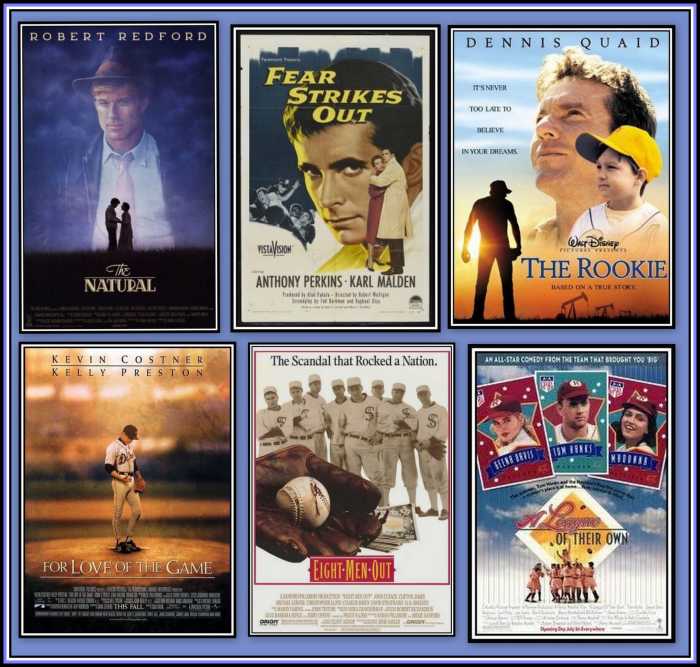
Another
baseball film of note was
the original version of Angels
in the Outfield with
the terrific Paul Douglas
playing the manager of a
losing Pittsburgh
Pirates team. The
manager has a terrible
temper and he rants and
raves at his players
using foul language. His
behaviour eventually
causes an Angel to
visit. After some
discussion, the angel
agrees to bestow some
miracles on the team
if the manager stops
swearing. The
Angel’s visits soon
become national news,
which brings all sorts of
problems to the manager.
Like all such tales, the
ending is happy, I am
glad to say, and all’s
well that ends well.
Angels in the Outfield
was remade recently, but
did not enjoy the same
success of the original
production.

Since
living here in the United
States, I look forward to
each April, as this is
when the Baseball Spring
Training takes place
and the members of the
team are finalised. Soon
it is Opening Day when
the first home game of a
team is played. This
takes place in very much
a carnival-like
atmosphere. Following
this, we all settle down
to 161 additional games
played between then and
September. Games are
shown on television most
days and, at the end of
the day, the games played
are dissected by
ex-players and sports
writers ad nausiam and
discussed at length. I
used to watch the games
of The Braves when
they were shown regularly
on television. When I
moved to where I live
now, I was overjoyed to
learn that Braves’
games could be heard
on the one of the local
radio stations. Radio
suits the speed of
Baseball. Once people
crowded around a radio to
follow the progress of their
team. Work used to
stop as people listened
to the games of the Play
Offs and World
Series. And now I
have the opportunity to
do the same and get to
spend many happy
afternoons sitting in my
garden and imagine the
game.
Thanks to
Johnny, I learned that
there was such a game as
baseball and I will
always be grateful to him
for this. But sadly, he
had not given us any
information on how it was
actually played.
Fortunately this was to
be the unexpected prize
awaiting us at the end of
our Saturday afternoon
odyssey to the Empress,
Mare Street, Hackney.
For there on the screen I
saw for the first time a
group of men playing a
game that I had assumed
was only played by kids
and by indians
on horseback.
It was a revelation and
on that day my
fascination with the game
truly began and which has
continued to this day.
|